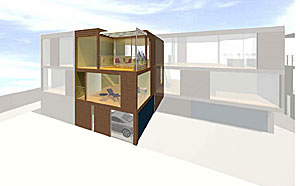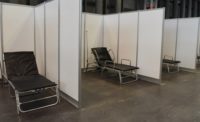When Steve Glenn launched the Santa Monica–based development firm LivingHomes in April 2006, he also initiated a tradition of engaging high-profile architects. SCI-Arc co-founder Ray Kappe, FAIA, created the company’s first line of prefabricated, sustainable modular houses, and David Hertz, AIA, has since developed a model comprising an aluminum-based panelized system. Yesterday LivingHomes unveiled its first multifamily product, designed by the progressive Philadelphia studio KieranTimberlake.


Although Glenn has already found a purchaser for these townhouses, he and KieranTimberlake originally developed the design on spec. Ecologically, Glenn says of his decision to pursue multifamily housing, “the most responsible thing to do is urban infill.” The building type is better suited to economies of scale in manufacturing, too. “Prefab is really about doing the same thing again and again, it’s mass production, and multifamily is optimized for that,” Glenn says. KieranTimberlake partner Stephen Kieran, FAIA, adds, “Reducing the cost of housing is largely contingent upon quantity.”
The townhouse features two stories of living space placed on top of a garage. Interiors, which measure approximately 1,500 square feet, are available in four configurations that include two bedrooms, two bathrooms, and a flexible space. The townhouses link laterally, making very large-scale development possible, although Kieran says that site and party-wall conditions would make it difficult to expand a series of townhouses after initial installation. The design currently sells for $185 per square foot; Glenn forecasts that per-square-foot price to drop $50 with increased production volume.
Kieran notes that previous attempts to produce prefabricated multifamily buildings, among them “prototypes from the ’60s and ’70s, including Paul Rudolph’s housing outside New Haven and Moshe Safdie’s Habitat,” failed to catch on. Companies such as GE Capital Modular Space have also deployed prefabricated modular construction for dormitories. “I wouldn’t call it a first,” Kieran says of LivingHomes, “but nothing has had this environmental ambition.”
LivingHomes’s sustainability requirements call for water efficiency and the use of recycled and VOC-free materials and finishes. Moreover, the higher density of multifamily development—particularly in those urban infill situations—is inherently green. The townhouses’ unique construction platform also achieves the dual benefits of minimizing labor cost and environmental impact: bathrooms and kitchen modules hook into a modular utility core, as do light-gauge-steel-frame panels that comprise the other rooms. These panels integrate the building envelope, structure, mechanicals, and interior finishes into a single component.
This proprietary platform, called the LivingHomes Building System (LBS), distills KieranTimberlake’s previous research in factory-produced architecture, specifically its Loblolly House and its commission for “Home Delivery: Fabricating the Modern Dwelling,” an exhibition that opens at the Museum of Modern Art, in Manhattan, on July 20. “We’re trying to collapse the essence of those ideas using fewer elements and fewer systems to work at a lower price point,” Kieran says.
Yesterday’s announcement also includes the launch of a KieranTimberlake single-family product. But while that design also takes advantage of the module-panel LBS, Kieran says the collaboration with LivingHomes has really served as a gateway for his and James Timberlake’s practice, informing efforts like low-income housing for Bangladesh, which their students at the University of Pennsylvania are developing currently, and their Make It Right proposal for New Orleans.



Post a comment to this article
Report Abusive Comment